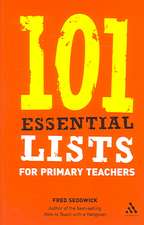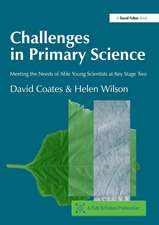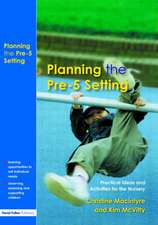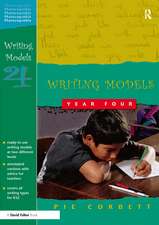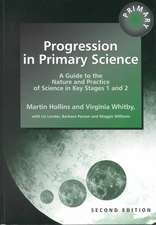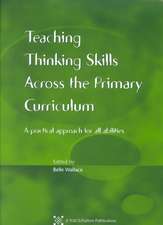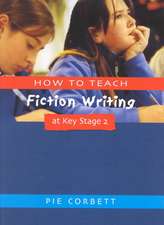Teaching Strategic Processes in Reading, Second Edition
Autor Janice F. Almasi, Susan King Fullertonen Limba Engleză Paperback – 5 oct 2012
This accessible teacher resource and course text shows how to incorporate strategy instruction into the K–8 classroom every day. Cutting-edge theory and research are integrated with practical guidance and reflections from experienced teachers of novice and struggling readers. The book describes the nuts and bolts of creating classroom contexts that foster strategy use, combining explicit comprehension instruction with scaffolded support, and providing opportunities for students to verbalize their thinking. It features reproducible learning activities and planning and assessment tools.
New to This Edition
*The latest knowledge and classroom-tested methods.
*Chapter on response to intervention (RTI).
*Chapter on organizing instruction across the school day and week.
*Expanded practical content, including sample lessons and more early literacy and upper-elementary examples.
Preț: 372.79 lei
Nou
Puncte Express: 559
Preț estimativ în valută:
71.34€ • 77.47$ • 59.93£
71.34€ • 77.47$ • 59.93£
Carte disponibilă
Livrare economică 01-15 aprilie
Preluare comenzi: 021 569.72.76
Specificații
ISBN-13: 9781462506293
ISBN-10: 1462506291
Pagini: 364
Dimensiuni: 178 x 254 x 23 mm
Greutate: 0.68 kg
Ediția:Second Edition,.
Editura: Guilford Publications
Colecția Guilford Press
ISBN-10: 1462506291
Pagini: 364
Dimensiuni: 178 x 254 x 23 mm
Greutate: 0.68 kg
Ediția:Second Edition,.
Editura: Guilford Publications
Colecția Guilford Press
Notă biografică
Janice F. Almasi, PhD, is the Carol Lee Robertson Endowed Professor of Literacy Education at the University of Kentucky, where she teaches courses in literacy research and theory. She is a former elementary school teacher and reading specialist and a former member of the Board of Directors of the Literacy Research Association and the International Reading Association. Dr. Almasi’s research, which has been recognized with several awards, has examined the contexts in which children learn from text, particularly in terms of strategic processes and peer discussion environments.
Susan King Fullerton, PhD, is Associate Professor in Literacy and Teacher Education at Clemson University, where she teaches courses in literacy methods, literacy research and theory, and the roles of the literacy specialist and coach. She formerly worked as a teacher of the deaf, a reading specialist, a Reading Recovery teacher, a Title I staff developer, and a literacy coach, and she continues to work in classrooms collaboratively with teachers. Dr. Fullerton's research focuses on struggling readers, strategic processes in reading, comprehension, the literary responses of young children, and literacy acquisition and instruction for deaf children. She is a principal editor for the 61st Yearbook of the Literacy Research Association.
Susan King Fullerton, PhD, is Associate Professor in Literacy and Teacher Education at Clemson University, where she teaches courses in literacy methods, literacy research and theory, and the roles of the literacy specialist and coach. She formerly worked as a teacher of the deaf, a reading specialist, a Reading Recovery teacher, a Title I staff developer, and a literacy coach, and she continues to work in classrooms collaboratively with teachers. Dr. Fullerton's research focuses on struggling readers, strategic processes in reading, comprehension, the literary responses of young children, and literacy acquisition and instruction for deaf children. She is a principal editor for the 61st Yearbook of the Literacy Research Association.
Cuprins
1. What Does It Mean to Be Strategic?
2. Critical Elements of Strategies Instruction: Designing Effective Environments
3. Responsive Teaching Frameworks within Response to Intervention
4. Assessing Strategic Processing
5. Why Students Struggle with Comprehension
6. Strategy Instruction That Enhances Comprehension
7. Strategy Instruction That Enhances Word Recognition
8. The Path to Becoming a Successful Strategies Teacher
9. Conclusions: Putting It All Together
Children's Literature
Recenzii
"This is a compelling and powerful book that masterfully grounds strategic processing instruction in both theory and research. It is an excellent resource to help classroom teachers and literacy specialists develop the extensive knowledge base needed to self-regulate their practice. New chapters in the second edition assist teachers in planning and organizing instruction and implementing it within an RTI framework. The discussions in these chapters are essential because they help bridge the gap between research and practice."--Lynn E. Shanahan, PhD, Department of Learning and Instruction, University at Buffalo, State University of New York
"This second edition takes an already excellent book and makes it even better! With a rich research base and real-life classroom examples, the book shows teachers how to take on the challenge of teaching strategic processes in reading, including how to do so within RTI frameworks. Perfect for teacher study groups and master’s courses, this comprehensive book guides teachers step by step to create motivated, strategic readers."--Mariam Jean Dreher, PhD, Department of Teaching, Learning, Policy, and Leadership, University of Maryland, College Park
"The professional literature often downplays the challenge of effectively teaching comprehension strategies. Thank goodness we have Almasi and Fullerton's splendid book to support our efforts. This text is an indispensable part of my graduate teaching; it provides a coherent model for developing and delivering strategy instruction. I particularly appreciate the excellent sections on the explicit teaching of strategies and the scaffolding of students' learning, as well as the annotated lesson plans. The second edition supplements these features with expanded information on RTI. Most notably, this book is solidly research based and not just a compendium of recommended practices. It is a powerful, comprehensive resource that can be adapted for diverse audiences and purposes."--Rachel Brown, PhD, Director, Literacy Master's Programs, Syracuse University
-"This second edition takes an already excellent book and makes it even better! With a rich research base and real-life classroom examples, the book shows teachers how to take on the challenge of teaching strategic processes in reading, including how to do so within RTI frameworks. Perfect for teacher study groups and master’s courses, this comprehensive book guides teachers step by step to create motivated, strategic readers."--Mariam Jean Dreher, PhD, Department of Teaching, Learning, Policy, and Leadership, University of Maryland, College Park
"The professional literature often downplays the challenge of effectively teaching comprehension strategies. Thank goodness we have Almasi and Fullerton's splendid book to support our efforts. This text is an indispensable part of my graduate teaching; it provides a coherent model for developing and delivering strategy instruction. I particularly appreciate the excellent sections on the explicit teaching of strategies and the scaffolding of students' learning, as well as the annotated lesson plans. The second edition supplements these features with expanded information on RTI. Most notably, this book is solidly research based and not just a compendium of recommended practices. It is a powerful, comprehensive resource that can be adapted for diverse audiences and purposes."--Rachel Brown, PhD, Director, Literacy Master's Programs, Syracuse University
Descriere
This accessible teacher resource and course text shows how to incorporate strategy instruction into the K-8 classroom every day. Cutting-edge theory and research are integrated with practical guidance and reflections from experienced teachers of novice and struggling readers. The book describes the nuts and bolts of creating classroom contexts that foster strategy use, combining explicit comprehension instruction with scaffolded support, and providing opportunities for students to verbalize their thinking. New to this edition: the latest knowledge and classroom-tested methods; chapter on response to intervention; chapter on organizing instruction across the school day and week; etc.

